
IT’S a tall order to ask a single 4x4 to excel at all facets of the off-road world, however, I reckon I’ve ticked all the boxes with this dinosaur-engined 100 Series (HZJ105R) Land Cruiser.
This review was first published in 4x4 Australia’s December 2012 issue.
From winching or snatching bogged trucks out of magazine photo-shoots, to hauling camper trailers and caravans around the countryside, to trying to avoid rock rash while tip-toeing through angry boulders, to floating over powder-soft sand or plugging though mud that sticks like you know what to a shovel, this Cruiser has to tackle all that and more on a regular basis.
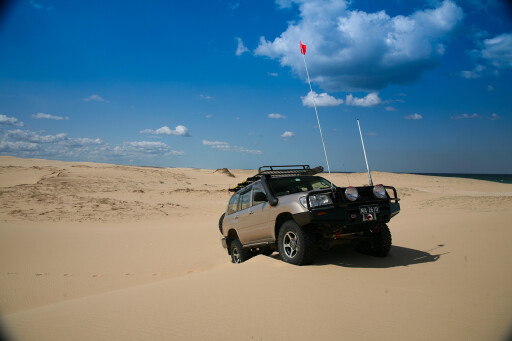 What could possibly be more? Try carting a tribe of kids all over the country – those plain-Jane vinyl floors really come into their own when it’s time for a clean.
What could possibly be more? Try carting a tribe of kids all over the country – those plain-Jane vinyl floors really come into their own when it’s time for a clean.
Once hosed off, though, the big Cruiser is perfect as a daily driver and can tackle shopping centres and drop the kids at school, and it’s just as easily driven by my wife, who’s not mechanically-minded. Now, that’s one big ‘must-do’ as far as I’m concerned.
I’ve spoken with many custom vehicle owners over the years who mention they’d never let their partners drive their truck for fear of cooking the over-boosted turbo system, rolling the over-suspended gangly-looking set-up or even for fear of breaking down.
We have none of those fears with this ever-reliable set-up; although, unfortunately, we did suffer one major breakdown that was totally unrelated to any of the mods that have been done. Rather, it was, what I reckon, a design fault of Toyota, but more on that later.
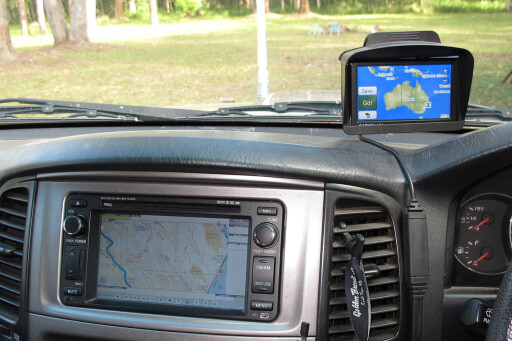 I own this Cruiser and, strangely – or cleverly, depending on where you sit – enough, given the access I have to the industry’s latest and greatest gizmos, I choose to keep it mild rather than wild. It’s not packed full of the latest high-tech electronic gadgets, it hasn’t had an engine conversion, and it doesn’t stand tall among some others we’ve seen on the tracks.
I own this Cruiser and, strangely – or cleverly, depending on where you sit – enough, given the access I have to the industry’s latest and greatest gizmos, I choose to keep it mild rather than wild. It’s not packed full of the latest high-tech electronic gadgets, it hasn’t had an engine conversion, and it doesn’t stand tall among some others we’ve seen on the tracks.
Nope, this sensibly accessorised Cruiser has everything it needs to do its job – during and after business hours – and not a skerrick more to weigh it down.
That’s been a major consideration too: the weighty issue of accessorising for the sake of it. Being sensible with accessories is an art form these days, especially in light of the plethora of gimmicky bits and pieces available for many vehicles – many not worth their weight in two-bob plastic.
That’s not to say this Cruiser is lightweight. Unfortunately, some of the most-needed parts are heavy but well worth it in the long run. That’s where careful planning and foresight helps in selecting the right parts, while making allowances for extra weight.
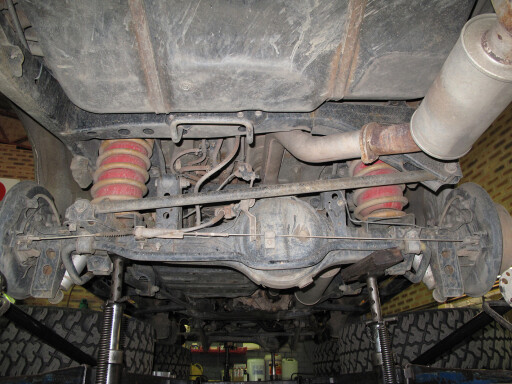 Starting from the ground up, I opted for reasonably heavy duty two-inch raised Tough Dog coils for front and rear, together with nine-stage adjustable Tough Dog 45mm shocks and Polyair airbag inserts for the rear coils. The all-round adjustability of the ride (via the shocks) and the load-carrying (via the Polyairs and coils) was the build-up’s foundation.
Starting from the ground up, I opted for reasonably heavy duty two-inch raised Tough Dog coils for front and rear, together with nine-stage adjustable Tough Dog 45mm shocks and Polyair airbag inserts for the rear coils. The all-round adjustability of the ride (via the shocks) and the load-carrying (via the Polyairs and coils) was the build-up’s foundation.
This set-up provides plenty of suspension flexibility on the harder tracks, firmness for good on-road driveability; plus good load-carrying ability while towing and packed to the gunnels, without resulting in sagging-rear-end syndrome.
The Tough Dog adjustable steering damper also helps with the weighty larger 285/75R16 Cooper ST rubber wrapped around the alloy CSA Stampede 16-inch rims – they’re a 16 x 8 with a 5/150 PCD and 0 offset.
To help the Cruiser get over the ‘wanders’, an ARB polyurethane two-degree castor kit has been added to the front control arms. So, does the whole show steer dead perfect? Nope, not at all, but it’s pretty good considering the off-road orientated, deep-treaded rubber, taller flexible coils and the extra weight of the rear ARB dual-wheel carrier aboard.
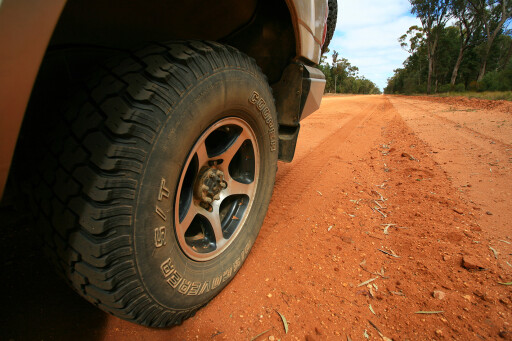 While having two spares aboard all the time may seem like a little overkill, given the use this Cruiser gets, it’s good precautionary insurance to avert holding up jobs out in the scrub too long should a tyre pop. Plus, having that second spare does bode well with security for the family while out in the boondocks.
While having two spares aboard all the time may seem like a little overkill, given the use this Cruiser gets, it’s good precautionary insurance to avert holding up jobs out in the scrub too long should a tyre pop. Plus, having that second spare does bode well with security for the family while out in the boondocks.
To ensure maximum ‘go-forward’ drive is passed down to the rubber, front and rear manually-operated TJM ProLocker diff locks have been fitted, together with an underbonnet-mounted air compressor, to which an extra air hose can be connected for tyre-inflation duties.
Leading the way through the long country drives in the dead of night is a set of HID Narva spotties, which are fitted to an ARB steel winch bar. This bar is also a resting place for a GME UHF aerial that is hooked up to an Icom IC-400PRO UHF radio. A Warn XDC (Extreme Duty Cycle) 9500lb winch with wire rope serves duty for recovering vehicles – and stuck cows from mud baths, believe it or not.
While this winch may not be the fastest on the block, it does pack plenty of pulling power and, hey, I’m not in any competition-type hurry. Plus, the water- and dust-proof contactor pack is far more reliable than the older-style solenoids in many other winches.
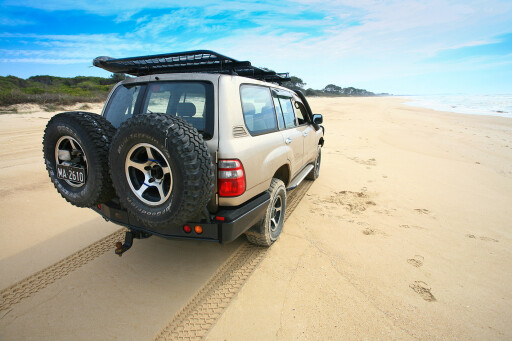 The aforementioned rear ARB wheel-carrier carts two 33-inch spare wheels and, while not designed to do so, also serves as a step up to the mismatched roof-rack set-up of three Rhino commercial cross bars with a rather crudely attached full-length aluminium rack bed left over from one of my previous 4x4s.
The aforementioned rear ARB wheel-carrier carts two 33-inch spare wheels and, while not designed to do so, also serves as a step up to the mismatched roof-rack set-up of three Rhino commercial cross bars with a rather crudely attached full-length aluminium rack bed left over from one of my previous 4x4s.
Amusingly, or embarrassingly, that rack was temporarily put up there about six years ago and has served so well that it’s become a permanent fixture and is a talking point to all who notice how it’s attached. While I’ve been part of many engine transplant stories – V8 petrol and replacement diesels, many of which are simply brilliant – I’ve chosen to stick with the old dinosaur-era, sleepy 1HZ naturally-aspirated diesel engine.
There has been a huge increase in oomph via a DTS water-cooled Mitsubishi TDO5H turbo and top-mount intercooler, though, which incorporates a stainless-steel heat guard and a GU Patrol bonnet scoop to direct the air into the horizontally-positioned radiator.
A three-inch mandrel-bent Beaudesert exhaust system with a ‘straight-through’ muffler completes the power-up system and returns a nice engine and turbo note without being too intrusive or annoying. All up, this prehistoric engine has been safely upped from just 95kW and 260Nm at the flywheel to an impressive 153kW and 430Nm – that’s more than a 60 per cent increase and a set-up that hasn’t returned a single problem in almost 70,000km of use.
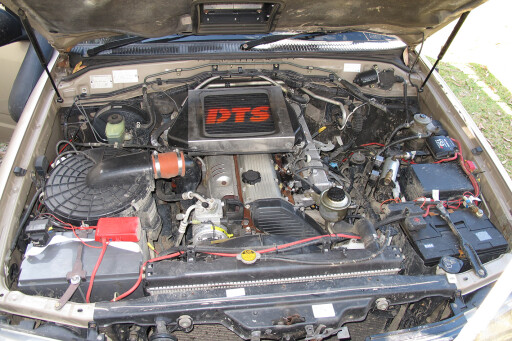 While the turbocharged 1HZ used to breathe through a washable/reusable K&N air filter, I’ve since reverted to good old replaceable paper units. There wasn’t anything wrong with the washable versions, I just couldn’t be bothered going through the cleaning routine and am just as happy putting a totally clean new one in each time.
While the turbocharged 1HZ used to breathe through a washable/reusable K&N air filter, I’ve since reverted to good old replaceable paper units. There wasn’t anything wrong with the washable versions, I just couldn’t be bothered going through the cleaning routine and am just as happy putting a totally clean new one in each time.
Under the bonnet, a secondary AGM deep-cycle Fullriver 120 amp hour battery is squeezed into a custom-made battery holder and is charged via a Projecta 150 amp battery (smart) isolator. That battery provides up to four days power to the 20-year-old 40-litre Engel fridge that usually resides in the rear cargo area.
The homemade steel tube-frame incorporates the fridge slide and a top-shelf setting that has proven invaluable for storing camp chairs, a solar panel and MaxTrax, and it’s also stuffed full of pillows and blankets when the family tags along. And, none of that gear finds its way onto the kids’ heads thanks to the Milford cargo barrier.
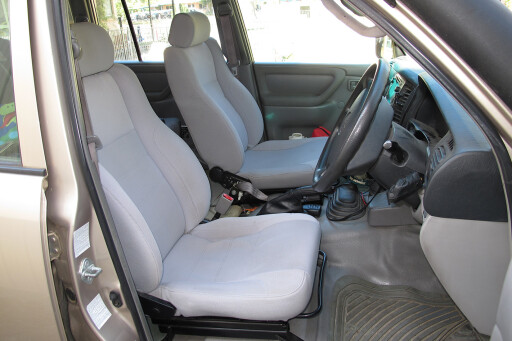 In an effort to protect the Cruiser’s sills from rock rash and to help with ingress into the higher riding cabin, I’ve had a custom set of sliders/steps grafted to the chassis rails by Macquarie 4x4, in McGraths Hill, NSW. These steps are strong enough to support the weight of the Cruiser on a high-lift jack and are upswept to enhance ground clearances.
In an effort to protect the Cruiser’s sills from rock rash and to help with ingress into the higher riding cabin, I’ve had a custom set of sliders/steps grafted to the chassis rails by Macquarie 4x4, in McGraths Hill, NSW. These steps are strong enough to support the weight of the Cruiser on a high-lift jack and are upswept to enhance ground clearances.
While I would like to get better fuel consumption – who wouldn’t? – I’m generally happy with the 13 to 14L/100km (not towing) I’ve been getting. Not great, but okay for such a large, heavy 4x4. As far as what extra parts I’d like to see bolted on; better seats are at the top of the list, followed by a set of LED light bars to throw out more light to the sides when off-road at night, an air tank – and I should really fix that roof rack set-up.
There’s no doubting there are tougher, more hardcore weapons out there. So too are there better highway performers as well as far superior, more economic, fuel-feasting engines, but you know what? I reckon that after 70,000km of hard service, this old Land Cruiser really is a Jack-of-all-trades and is damn near master of every single one.
SOME STRIFE
AN AIRTEC snorkel and diff breather extensions have been fitted to allow for safer wading; although, in an unfortunate incident the mighty Cruiser was flat-towed for major surgery after the fan blade ripped the radiator apart. The water crossing wasn’t all that deep, but the steep, soft sand bank at the exit, combined with towing a camper trailer, meant several attempts at conquering it.
With the reversing into the water after each failed attempt, the fan blade struck the water, twisted forward and gave the old radiator several extra water outlets – which led to overheating and a cracked head.
Now, this is where I’ll throw a little blame Toyota’s way. Did you know that Toyota has three different fan blades for the 100 Series Land Cruiser – each of which may or may not have been fitted to any 100 Series from any country? All three are the same size, have the same number of blades (eight) and are interchangeable into the standard central fan hub.
 But, one huge difference is the flexibility of each fan’s blades. Some are almost able to be pushed, by hand, into the radiator, whereas others are much stiffer. For anyone else that pedals a 100 Series, have a look on your fan blades for a coloured paint dot about the size of a 5- or 10-cent piece – it’ll be blue (the most flexible one and what I had) or yellow or red (the more rigid options).
But, one huge difference is the flexibility of each fan’s blades. Some are almost able to be pushed, by hand, into the radiator, whereas others are much stiffer. For anyone else that pedals a 100 Series, have a look on your fan blades for a coloured paint dot about the size of a 5- or 10-cent piece – it’ll be blue (the most flexible one and what I had) or yellow or red (the more rigid options).
Needless to say, once I found the problem I swapped over and have never had that problem again but, of course, I also use a water blind if my Cruiser is wading through very deep water. Tyre-wise, I’ve only suffered one puncture in the big Coopers: a bloody nail straight through the tread.
The dodgy, cheap bucket seats I’m using have been re-upholstered once already due to the internal foam falling to bits. They’re getting close to needing another upgrade – perhaps they’ll get the flick and I’ll try a better set to help support my aging back.
 Due to their oversized outer body diameter, the Tough Dog shocks just touch the swaybar arm at full flex. It’s nothing to worry about bar a bit of scratched paint and doesn’t affect the workings of the shock or swaybar.
Due to their oversized outer body diameter, the Tough Dog shocks just touch the swaybar arm at full flex. It’s nothing to worry about bar a bit of scratched paint and doesn’t affect the workings of the shock or swaybar.
Other than that, I’m happy to report no other failings or major problems and would happily rebuild an identical truck if the need arose. However, I’d probably go for a GXL rather than the standard barn-doored wagon to incorporate a few little luxuries, such as electric windows and central door locking.
That’s right, I’m still winding the windows up and down manually and that’s a bit of a pain. Being able to do it from the driver’s seat would be brilliant; so too would the ability to unlock all four doors at once instead of walking around them all. Technology – ain’t it grand?

COMMENTS